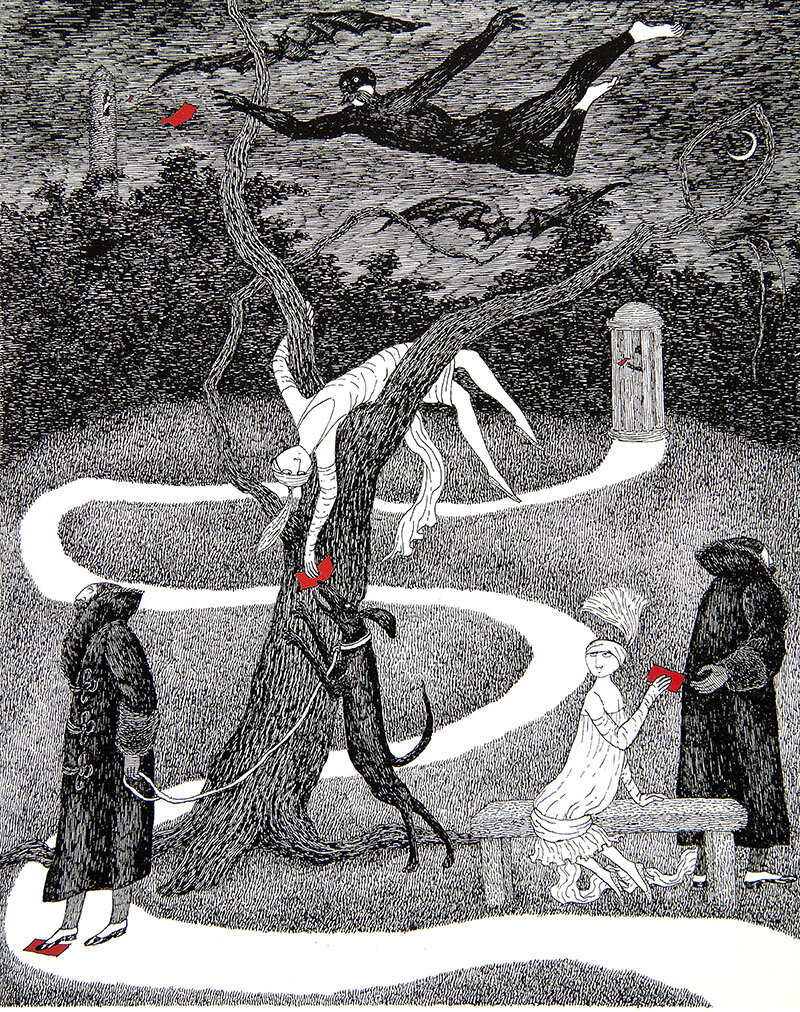Murder He Wrote: Edward Gorey and the Art of the Mystery
The Edward Gorey House 2018 exhibit investigates Edward Gorey's life-long fascination for the murder mystery genre. Crime writers — specifically Agatha Christie — but also including Dorothy Sayers, Georgette Heyer, Josephine Tey, Michael Innes, Margery Allingham, Edmund Crispin, and Cecil Street (among others) were the passion of a man who some might have considered to be somewhat passionless. As his father, Edward Leo Gorey, was at times a crime reporter for various Chicago papers we might actually say that crime writing literally ran through Gorey's blood.
Maybe as much as he loved cats, or ballet, or rocks, or elephants, or India ink, Edward Gorey loved a good mystery and it proved to be a very formative genre for him. As an illustrator/author, so many of Gorey's visual devices and narrative styles are drawn directly from the murder mystery handbook: distinctly British, vaguely interwar, genteel, understated, and savage (in a genteel, understated way). However, unlike Christie and the whole murderous brood of English crime writers, Gorey is also very funny.
Murder He Wrote reveals Gorey's strange world of suspicious characters, red herrings, and inconclusive revelations. It is a crosshatched black and white world of both rigid social class and brutal anarchy where nothing much happens — until it does. It is, in fact, a world very much like its author: brimming with false clues and mystery.
The artwork in this exhibit features The Awdrey-Gore Legacy (1971) which is, among other things, a dissection of the components of a murder mystery as well as an homage to the genre. Gorey dedicated this book to Agatha Christie who died in 1976. It is not known whether she ever saw, or what she would have made of, The Awdrey-Gore Legacy or additional titles in the exhibit including The Other Statue (1968), The Deadly Blotter (1997) and The Helpless Doorknob (1989) among other works — some pieces never before publicly exhibited. Unknown is the whereabouts of a mysterious letter Agatha Christie sent to Edward possibly in response to a letter he sent her.
The contract, long established between mystery writers and their readers, is this: that disarray will be reassembled, like a puzzle, into a whole again. However, because this exhibit features the work of Gorey as a murder mystery writer, you can be pretty certain that this contract will be broken. Actually, you can count on it. The mystery of the Mystery is that it is a mystery— when drawn by Gorey. While reveling in this stuffy world of righted wrongs, Gorey is also a very contemporary human, leaving us with false clues and broken promises. Gorey constantly tears up the contract between himself and the reader, but in return, the rewards can be satisfying and the bond strong. Gorey is always at his most engaging when he lets his reader fill in the blanks and draw conclusions. You, his dear Reader. are now in cahoots with the Writer and an active part of the landscape that he’s drawn you into: a strangely beautiful, odd, whimsical-yet-dangerous place.
In other words: welcome to the modern world.


